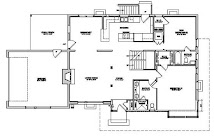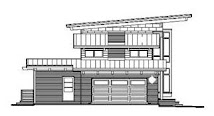
The cedar siding started going up yesterday. I've been looking forward to this so I can get a better vision of how the outside colors will work together. Having the cedar boards in place will help me select the color of the stone for the chimney and the paint color on the brick. The paint color can wait a while but I'd rather go ahead and make that decision with the stone choice.
The cedar is being applied over a "rain screen" product that is a hard, yellow, plastic mesh. This mesh will provide a layer of air to circulate behind the cedar. Any water that penetrates the boards or joints will gravitate through this zone to the ground below. The primary layer of water protection is the Tyvek and flashings that cover the wall. This airspace should greatly lengthen the life of the cedar as well.
You will see rain screens being used more frequently. The theory is that the visible exterior skin is in place specifically to block some of the precipitation and all of the sun - nature's primary tools of destruction. The interior layer of a building's exterior wall includes the final layer of waterproofing (Tyvek and flashing), the structure, thermal blanket, and the interior finish surface.

The idea for a rainscreen is that this open space allows air to circulate and moisture to escape from behind the outer skin. If the moisture is trapped behind the outer layer (regardless of the material), it will do some very bad things. Moisture will expand when it freezes and slowly delaminate a wall. Moisture inside a wall can also create mold which will cause rot and health issues.
An example of this failure can be found in the first buildings to use EIFS (exterior insulation finish system) back in the early 80's. EIFS was also called by its proprietary name - Dryvit. This product became popular because you could glue rigid insulation foam over the outside of any hard wall and coat it with a stucco material. It was fairly easy to install, gave you great insulation values and you could cut it to any shape you could imagine.
However, what began to occur with poor installations was that water would find its way into the joints and freezing temperatures would pop the insulation off. The product got a bad name and was actually banned in North Carolina - until a rainscreen system was created to drain any wayward water out from behind the outer insulation layer.
Brick veneer walls usually behave as rainscreens. Brick is a porous material and water will easily wick through it. To rid the water that migrates through the brick, there is an airspace of 1-2" to let migrating water run down the inside face of the brick. This only works when there is a way for the water to escape through "weep" holes at the bottom of this cavity.
Rainscreen materials may vary, but the concept is the same.








No comments:
Post a Comment